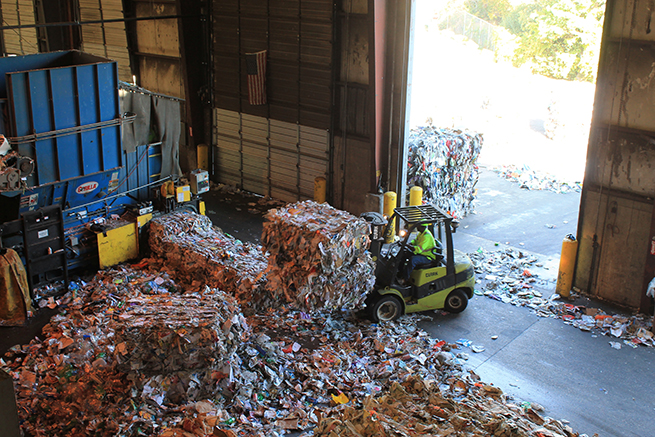For the past six months, we’ve been raising concerns about how the City of Ann Arbor is managing its recycling program after it terminated a contract with the operator of its materials recovery facility (MRF). City officials have responded that the recyclables all got recycled through other MRFs, and that raises the question:
Does it really matter who runs your MRF?
In fact, it makes all the difference in the world.
Here’s the Recycling 101 explanation of what happens to old plastic containers, paper, and other recyclables after you put them out on the curb:
They get picked up by a recycling truck, and eventually delivered to plastics factories, paper mills, and other reprocessors. Then they get re-made into new products for consumers but at a fraction of the climate emissions, air and water pollution, and resource depletion that comes from making those products out of raw materials.
But there’s a step between the curbside truck and the reprocessing plants. It’s at the MRF that materials get sorted, prepared, and marketed. It’s the key step in converting garbage into commerce. And what happens at the MRF varies a lot, depending on the design of the facility and the interests of the operator.

Not all MRFs sort alike. Different MRFs see a wide variance in residue rates, the percentage of incoming material that doesn’t go to end-markets because it was either mistakenly included in the recycling cart in the first place or because of imperfections in the MRF’s sorting process. Eureka Recycling achieves a 2% residue rate at its facility in St. Paul, Minnesota. When it was running, the City of Ann Arbor’s lost 7% to 10% of material to residue. Nationwide, some single-stream MRFs suffer residue rates as high as 30%. Typically, MRF residue gets landfilled or incinerated.
Some MRFs generate more end-market residue than others. While some materials end up as MRF residue, others get mistakenly sorted into the wrong loads. Sorting machinery may often treat flattened plastic as a paper product, and the MRF’s end-product sends plastic mixed in with paper to the mills, where it eventually get pulled out as end-market residue. Once again, the residue is typically landfilled or incinerated.
MRF operators can help develop markets for hard-to-recycle materials. Facing the same problems as communities everywhere are now having in finding markets for glass, Eureka Recycling worked with their state economic development agency to attract a glass benefication factory to improve the quality of glass coming out of the MRF and making it saleable to manufacturers who use it to make glass containers.
Communities can use their MRFs to troubleshoot problem areas in a recycling program. MRF operators can use their scale house data to identify neighborhoods with poor participation. They can inspect transfer station loads to learn what recyclables are getting thrown in the trash on a regular basis. That information can inform community education programs.
Labor standards also vary between MRFs. Recycling programs can be a good source of local jobs, and some MRFs pay their employees at above-living-wage levels. But others pay close to minimum wage, and working conditions are difficult.
A material recovery facility is the hub of any community’s recycling program. It can be a spark for regional economic development; a source of good local jobs; the key component in recycling education programs; and the guarantee that the environmental benefits of recycling actually get realized. The MRF makes the difference between a mediocre recycling program and a great one.

